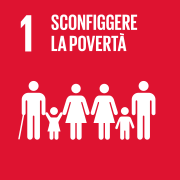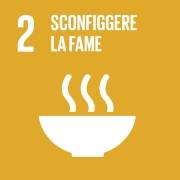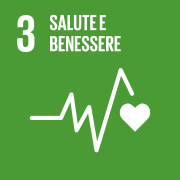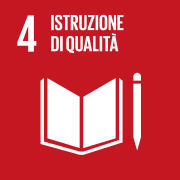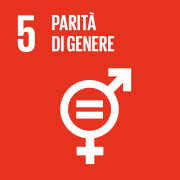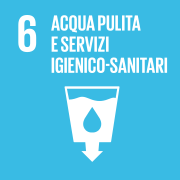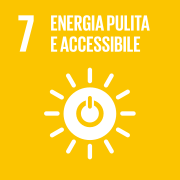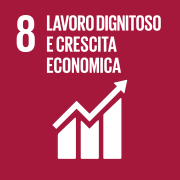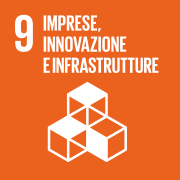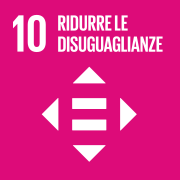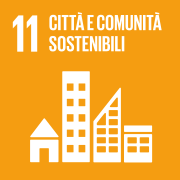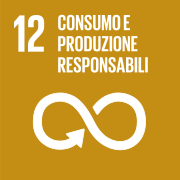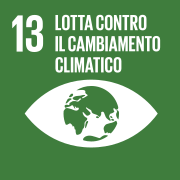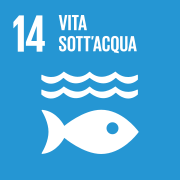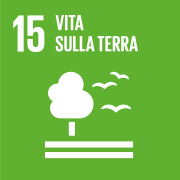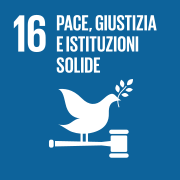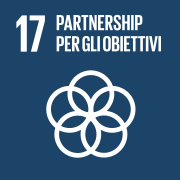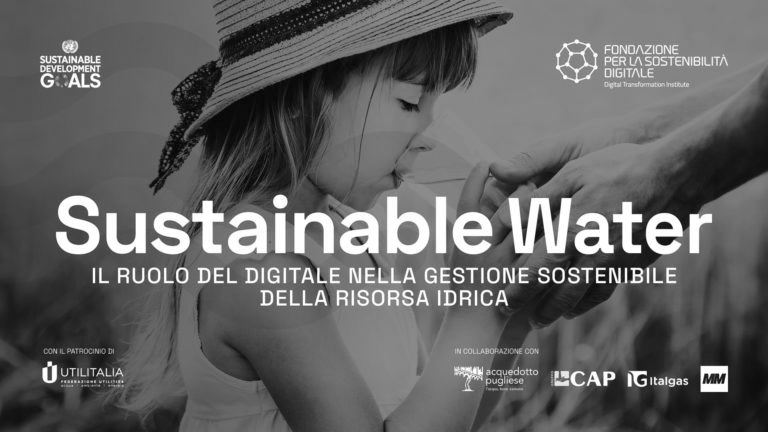
Water is a precious commodity, an essential element for life. Ensuring its availability and sustainable management is at the heart of the basic principles of the2030 Agenda and, to achieve this crucial goal, the contribution of digital technologies cannot be ignored.
Digital transition and digital transformation are in fact two phenomena that – the first from the point of view of redefining processes, the second from a perspective of meaning – profoundly redefine the relationship with the water resource: for this reason, it is now necessary to reflect on the ways in which these phenomena can and must be implemented in the water supply chains, so as to ensure an approach to this resource intermediated by technologies that is intrinsically sustainable. In other words, if water is the basis of life and its sustainable management is the basis of development, the digital sustainability of water is a fundamental key to the sector’s growth.
The Fondazione per la Sostenibilità Digitale (Foundation for Digital Sustainability) is convinced of this and, as part of the activities planned for 2024 and on the initiative of the supporting companies Acquedotto Pugliese, Gruppo CAP, Italgas and MM Spa, has promoted the establishment of the Sustainable Water working group, which in recent months has been working on the drafting of a Position Paper dedicated to this very issue. The document, which analyses the various digital technologies for the sector and how these, applied to 14 use cases, support the sustainability goals of Agenda 2030, was presented on 4 March during the conference ‘Sustainable Water: the role of digital in the sustainable management of water resources‘, organised in Milan at the Gruppo CAP headquarters.
The aim of the conference was to share the Position Paper with the main operators in the sector from the various Italian regions, with the hope of strengthening the partnership, broadening the composition of the group, and subsequently being able to launch concrete initiatives in a participatory manner. “We strongly believe in a systemic approach involving all the country’s Integrated Water Service operators, not only because of the strong push for technological innovation that this would produce, but also because of how operators could use the digital lever to achieve sustainability goals,” explained Stefano Epifani, President of the Foundation for Digital Sustainability. “The hope is therefore to establish a constructive dialogue and a collaborative process among all the Italian Integrated Water Service operators, which takes into account the different territorial needs of our country and is capable of evolving and enriching itself thanks to the contribution of all participants“.
“MM has always adopted digital technologies to efficiently, effectively and sustainably manage the water resource. Thisiswhy it has made its experience available to prepare, with other supporting members of the Foundation, the Sustainable Water Position Paper,” said Marzio Bonelli, CIO of MM Spa.“The document contains food for thought on the relationship between digital and sustainability objectives throughout the life cycle of the water service, with the hope of being able to involve other managers and face together the challenges that await us to sustainably manage a resource that is becoming increasingly precious.
The Foundation’s Vision
The role of water in our lives and its ‘perceived abundance’ in our country have meant that it has come to be regarded – wrongly – as something to be taken for granted. This erroneous perception seems to have created over the years a problem of awareness, culture and governance that have not been conducive to the planning of adequate investments in this sector: this is a problem, considering that in our country poor infrastructure leads on average to the loss of one drop out of every two.
In this context, digital transformation, if developed according to sustainability criteria, can play a strategic role in the effective management of water resources, also helping to define the types and value of investments in a targeted and optimised manner. In this sense, it is crucial to seize the opportunities that this historical moment offers: the PNRR, in particular, represents a great opportunity to support important investments in digital for the reduction of losses and the digitalisation of networks, and to foster circularity.
“Today even more than yesterday, the correct and coherent management of the water resource becomes fundamental. Digital is consequently one of the main levers for optimising its management and evolving towards a new generation functional model, with an eye to the SDGs of Agenda 2030,” explained Michele Tessera, Chief Information Officer of Gruppo CAP. “We have believed in and supported from day one the creation of the Sustainable Water group because ‘making a system’ between the managers of the integrated water service is a fundamental point to give a boost to technological innovation without losing sight of all the sustainability aspects“.
However, reads the paper produced by the Foundation, in addition to digital transformation, it is also necessary to work on the creation of a culture that not only embraces innovation and sustainability as core values, but is able to transform these ideas into concrete actions. In the water sector, which is characterised by a multitude of small and medium-sized enterprises, there is therefore a need to develop a new governance model that can maximise the potential of digital transformation, while at the same time guaranteeing sustainability and continuity once the projects and funding from the NRP are completed.
“The idea of founding a Community stems from the desire to offer greater support and flexibility in projects, especially for the benefit of smaller realities, which would otherwise find it difficult to act independently,” said Paolo Lanza, Director of Innovation, IT Management at Acquedotto Pugliese. “Participation in the Foundation, thanks to the vast and qualified network of members representing Italian excellence, fosters a fertile exchange on issues related to digital sustainability and allows us to optimise the effectiveness and impact of the initiatives promoted. This collaborative context is also propitious for initiating synergies with institutions, in order to promote a perception of digital as an opportunity for growth rather than as a mere cost‘.
Technologies supporting the water world
Looking more specifically at technologies, in the Position Paper they are classified into three areas, in relation to their function, which are interdependent.
- The first area is that ofphysical infrastructure: this concerns the technologies that manage the life cycle of assets and their representation in the territory(GIS, Geographic Information Systems), their operation(IIoT) and the technological and network infrastructures that enable the transmission and processing of information in real time(broadband and Cloud);
- The second area is that ofprocess infrastructure: building on the previous one, it concerns technologies capable of optimising processes, developing new services and rethinking the traditional way of working through predictive analyses based on artificial intelligence and Machine Learning algorithms;
- Finally, the third area is that of Digital Ecosystems: the latter contains solutions(Use Case) composed of the interconnection of one or more of the technologies described in the previous areas, capable of digitally representing the physical reality of the assets and their behaviour, as well as enabling the interaction between technologies and people who become an integral part of the system by conditioning their behaviour.
Each of the technologies mentioned in the three areas are discussed in detail in the Position Paper, and examples of their application in the water field are also given for each of them.
The 14 Use cases in the framework of the 2030 Agenda Goals
Following the logic of aggregating the above-mentioned technologies, 14 Use cases have been identified, real examples of how the use of a combination of digital tools allows to solve critical issues, optimise and evolve business processes. Furthermore, each use case was analysed systematically by correlating its impacts with the Agenda 2030 Sustainable Development Goals, thus identifying the benefits of using the different technologies applicable to each stage.
Use case 1, relating to the control of withdrawal systems, is for example related to the topic of increasing water efficiency(SDG 6 – Target 4). In this direction, the collection and analysis of data provided by theIIoT and the Digital Twin, processed by theAI, make it possible to optimise water withdrawal and distribution processes: this translates into an improvement in the efficiency of water management, reducing waste and promoting a more targeted and conscious use of water. And in an improvement of the long-term sustainability of the water system.
The seventh use case examined, concerning the reduction of leakage, impacts, among other things, on the development of quality, reliable, sustainable and resilient infrastructure(SDG 9 – Target 1). By cross-referencing information from water flows with other data (weather conditions, traffic conditions, repairs carried out on the network, etc.), the combination of IIoT, Big Data and AI technologies makes it possible to predict future failures, enabling operators to target preventive, targeted and reliable investments for high-risk pipe replacements: this not only reduces leakages, but also prevents cases of new hidden leaks.
“The digital transformation of networks is an enabler of development, efficiency and service quality. And in Italgas we know this well after having transformed the entire network to a smart, digital and flexible infrastructure that has brought gas distribution into the future,” said Marco Barra Caracciolo, CIO of Italgas. “A digital network can be controlled remotely, collects and transmits millions of data in real time, and operates like a nervous system capable of acting centrally and locally with immediate reactions to external stimuli. This know-how and technology can be borrowed to the water sector with immediate benefits, in terms of efficiency and sustainability, starting with the significant reduction of losses‘.
In short, digital technology can make a decisive contribution to the management of water resources and, as the Position Paper emphasises, its role must be included in a sustainability-oriented framework, inspired by the SDGs of Agenda 2030. But it is only through the development of a common vision, through collaboration between stakeholders, that existing solutions can be implemented to their full potential, ensuring better management of a resource that is as important as it is fragile, with a view to a more sustainable future.
